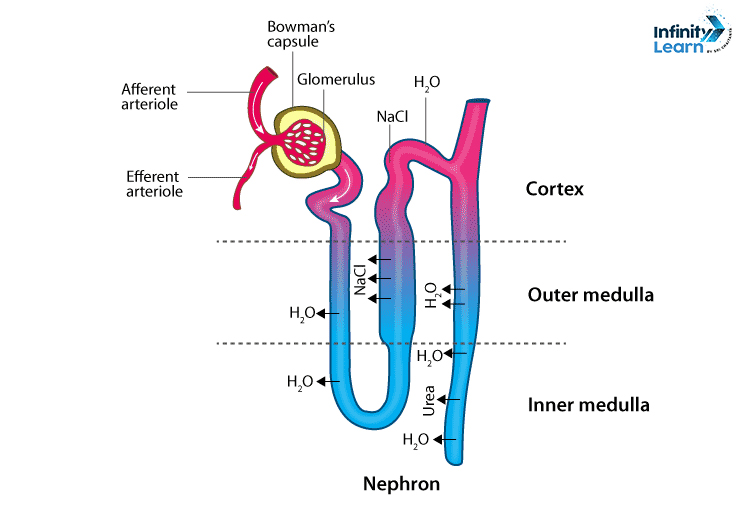





Courses

By Shailendra Singh
|
Updated on 16 May 2025, 12:06 IST
Nephron Diagram Class 10: In a Class 10 nephron diagram, one can observe the structure responsible for filtering waste and balancing fluids in the kidney. Similar to the nucleus in a cell, the nephron acts as the kidney’s processing unit. It filters blood, removing waste and excess substances. The diagram illustrates the renal capsule, a protective layer surrounding the nephron.
Inside, there are renal tubules where filtration and reabsorption occur. Additionally, you’ll notice the glomerulus, a tiny ball of blood vessels, and the renal corpuscle, which includes the glomerulus and Bowman’s capsule. This diagram simplifies understanding of how nephrons function in kidney filtration.
A nephron is a tiny structure found in the kidneys, playing a crucial role in filtering blood and producing urine. It’s like a miniature filtering factory inside the kidney. Each kidney contains thousands of nephrons, and together they help maintain the body’s balance of water, salts, and other substances.
Within the nephron, there’s a complex network of tiny blood vessels and tubules. The nephron filters waste products and excess substances from the blood as it flows through. It also reabsorbs essential substances back into the bloodstream. After filtration and reabsorption, the nephron forms urine from the remaining waste.
The body then passes this urine out. Essentially, nephrons are the kidney’s microscopic workhorses, ensuring that our blood stays clean and our body stays healthy.
A nephron diagram is beneficial for comprehending its structure and functions. This nephron structure diagram for class 10 helps in grasping how these components collaborate. Throughout this discussion, we’ll dissect each element and its respective function using a Nephron diagram.
In the human body, there are two main types of nephrons: cortical nephrons and juxtamedullary nephrons.
Around 85% of the nephrons in the kidney are cortical nephrons. These nephrons have short loops of Henle that only extend a small distance into the medulla. The glomerulus in these nephrons is located near the outer part of the kidney’s cortex. A nephron diagram for class 10 would typically show these features clearly in labeled diagrams.

The remaining 15% of nephrons are juxtamedullary nephrons, which have long loops of Henle that extend deep into the medulla. The glomerulus in these nephrons is located at the junction between the cortex and medulla. These nephrons play an essential role in producing concentrated urine and conserving water, which is crucial for maintaining fluid balance in the body.

The nephron is like a tiny factory in your kidneys that helps keep your blood clean and balanced. It has several important components and functions:
Each part plays a crucial role in keeping your blood clean and your body balanced. If any part isn’t working right, it can lead to problems like kidney disease or imbalances in your body’s fluids and chemicals.
Here are some simple pointers outlining the benefits of using a nephron diagram for a Class 10 student:
In summary, using a nephron diagram in Class 10 education provides multiple benefits, including clearer understanding, improved retention of information, and enhanced exam performance.

A nephron is the structural and functional unit of the kidney responsible for filtering blood and producing urine. A nephron diagram typically illustrates its components, including the renal corpuscle (glomerulus and Bowman's capsule), proximal convoluted tubule, loop of Henle, distal convoluted tubule, and collecting duct.
Nephrons are located in the kidneys, specifically in the renal cortex and renal medulla.
To draw a nephron diagram, start by sketching the renal corpuscle, followed by the proximal convoluted tubule, loop of Henle, distal convoluted tubule, and collecting duct. Label each component accurately to represent their structure and function.
The three main steps of nephron function in Class 10 typically include glomerular filtration, tubular reabsorption, and tubular secretion
Yes, the nephron diagram is important as it helps visualize the structure and function of the nephron, aiding in understanding kidney physiology and the process of urine formation.
In Class 10, the structure of a nephron includes the renal corpuscle, proximal convoluted tubule, loop of Henle, distal convoluted tubule, and collecting duct, which work together to filter blood and produce urine.